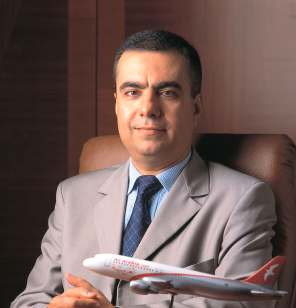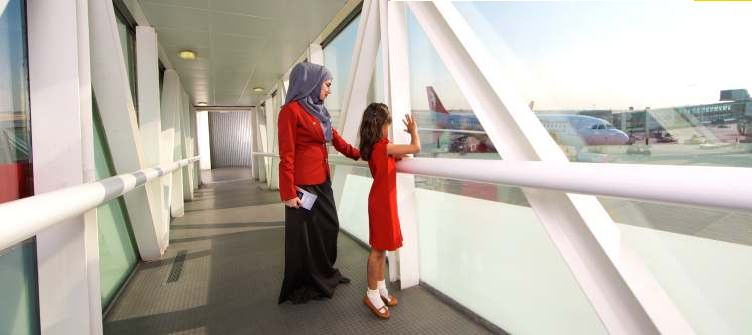Sharjah International Airport Four-fold expansion project moves full steam ahead
Sharjah International Airport is all set to receive 200 additional flights weekly this summer and has embarked on a large scale expansion project to continue offering excellent service to airlines and passengers
Sharjah is located between the city of Dubai and other Northern Emirates and known to be a thriving city, which is famous for its culture, heritage and numerous other tourist attractions. The emirate is also renowned to be a business hub which attracts entrepreneurs with its conducive atmosphere to business.
Sharjah International Airport’s history goes back to 1932, when it was known to be a stopover point by Imperial Airways – the forerunner of British Airways, which constructed an airfield at Sharjah as a stopover en-route to India and Australia.
Today, the airport is the Middle East region’s leading air transportation gateway and is considered to be a leading cargo hub in the region. In 2012, the airport added eight new cargo airlines to further enhance its position as one of the best cargo handling facilities and services in the region. Sharjah follows an ‘Open Sky Policy’ which permits airlines’ traffic rights without any hindrance.
Expansion project ongoing
To cope with air traffic increase, Sharjah International Airport has embarked on a four-fold expansion project; both air side and land side to ensure the excellence of quality service provided to airlines and passengers using the airport.
Expecting to see 25 million passengers by 2025, the airport is set to operate a new capacious runway alongside the old one by September this year. The project consists of the main runway spanning 4,060 meters and a width of 60 meters, has two taxiways and 10 connecting corridors which are intended to secure the aircraft out of the main runway in the shortest time to the hangar.
A senior official said the new airstrip will suffice the future needs of the third-biggest airport in the United Arab Emirates, particularly for large and new generation code-F aircraft such as A380, apart from the expected 14 million passengers in 2017 and the already one million tons of shipment capacity.
The airport has further contracted with construction company Bechtel to do a thorough development plan for the airport. The project also includes the implementation of a 15-km service road and the construction of a security fence extending 10 km as well as implementation of the rain water drainage network.
“The eight-month plan, to be ready this September, will identify the expansion trends of infrastructure projects in the airport and surrounding northern or southern areas,” said Ali Salim Al Midfa, Chairman of Sharjah International Airport.
Sharjah International Airport has reported 8 per cent increase in passenger traffic in the first quarter of this year. The passenger statistics showed that 2.25 million passengers used the airport from January to March 2014, growing from 2.08 million during the same period a year ago. In addition, aircraft movements increased to 16,373 while 51,045 and cargo activity handling rose to 51,045 tonnes.
There are leading airlines which operate flights from the Sharjah International Airport including Air Arabia, Air Blue, Air India, Air India Express, Cebu Pacific Air, Egyptair, Jet Airways, PIA, Qatar Airways and Srilankan Airlines and many others.
Besides, international cargo flights are also operated from Sharjah International Airport. Among these, Air Arabia is the main airline which flies to more than 90 airports throughout the world.
Sharjah International Airport believes its 2030 Master Plan will be able to attract new airlines. According to a top official, Sharjah International Airport is waiting to complete its 2030 Master Plan, which will include a logistics area connected to the planned Etihad Rail network.
Much of Sharjah’s growth over the past decade has been fuelled by Air Arabia that added eight new destinations this year. Sharjah International Airport handled 7.5 million passengers in 2012, a 13.6 per cent year-on-year jump from the previous year. In an effort to maintain these performance levels, Sharjah International Airport officials recently held discussions with the Ministry of Interior to develop facilities that will streamline passenger flows in and out of the airport.
The airport has become the preferred travel option of many because of the efficiency of procedures, excellent services and its strategic location.
The airport has also announced that it will see an influx of 200 additional weekly flights as airlines commence their summer schedule. The increase in weekly flights will come from a mixture of commercial and cargo operations including Srilankan Airlines, Qatar Airways and Saudia Cargo.
Furthermore, as Dubai International Airport’s runways are under renovation from 1 May until 20 July for 80 days, some of the flights have been diverted to Sharjah International Airport. This temporary move is expected to put additional pressure on the airport’s load. Among the airlines that have diverted their flights are Air India, Air India Express, Pakistan International Airlines (PIA) and Cebu Air Pacific.
“Sharjah International Airport is gearing up to meet with this new demand, both with regards to resource and infrastructure. Recently, the airport appointed 100 passport control officers, and opened 20 additional check-in counters to ease the travel and immigration formalities, as well as providing additional temporary gates to ensure the smooth and fast completion of the procedures,” added Mr. Al Midfa.
Sharjah Airport Authority (SAA) signed an agreement with Gama Aviation, the global aviation services company, permitting the company to manage private/business aviation services at Sharjah International Airport, including all procedures and processes, starting from issuing landing permissions to the handling of passengers and crews.
The agreement between SAA and Gama Aviation was signed by Ali Salim Al Midfa, Chairman of Sharjah Airport Authority and Richard Lineveldt, General Manager MENA for Gama Aviation respectively, in the presence of Shaikh Khalid Bin Essam Al Qasimi, Chairman, Department of Civil Aviation, Emirate of Sharjah.
Gama Aviation took over the responsibility for handling all business travellers at Sharjah International Airport in early 2012, but the company has been present in Sharjah as a charter operator since 2006.
 Leading low cost carrier – Air Arabia
Leading low cost carrier – Air Arabia
The government of Sharjah launched its own airline, Air Arabia, on October 28, 2003, which is a low-cost airline operating to 91 destinations in the Middle East, North Africa, the Indian subcontinent, Europe and Central Asia. The first flight was from Sharjah International Airport to Bahrain International Airport. Despite the tough competition in airline business, the airline is profitable from the first day of its commencement. As expected, the resultant increase in passenger throughput via Sharjah International Airport has been dramatic.
Air Arabia does not only transport passengers, but also offers cargo delivery services. The carrier operates cargo services to more than 50 destinations, which continuously grow.
Air Arabia deals with corporate customers in the region and worldwide such as Aramex, Emirates Post, UPS, FedEx and DHL. Furthermore, it is in bid to deliver cargo across a wider network, Air Arabia has expanded its cargo reach in collaboration with major freight carriers as interline partners such as Lufthansa, Cargolux, Singapore Airlines, Etihad Cargo, Air France, KLM, Oman Air, Leisure Cargo and many more.
Adel Ali, Group Chief Executive Officer Air Arabia, was awarded world’s low cost airline “CEO of the year” 2007, 2008, 2009 and has been given credit for setting up the Middle East and North Africa’s first low-cost carrier (LCC), Air Arabia.
Adel has brought over 27 years of strategic aviation, tourism and marketing experience to Air Arabia since the company commenced operations in October 2003. Adel’s distinctive leadership style, vision, skilful management combined with his charisma, makes him an inspiration to his team.
Fourth international base – RAK
On 6 May 2014, the airline started its operations from Ras Al Khaimah, one of the seven emirates in the UAE. The inaugural flight departed from RAK International Airport to Jeddah in Saudi Arabia. The launch of operations followed the recent establishment of an Air Arabia hub at RAK International Airport, which is the airline’s fourth international base, and second in the UAE.
Two new Airbus A320 aircraft have been based at Ras Al Khaimah International Airport, following a strategic partnership signed between the airline and Ras Al Khaimah Department of Civil Aviation. Air Arabia launch routes include direct services to Jeddah in Saudi; Cairo in Egypt; Muscat in Oman; Islamabad, Lahore and Peshawar in Pakistan; Dhaka in Bangladesh; and to be followed by Calicut in India.
Contract with Turkish Technic
Air Arabia recently selected the subsidiary of Turkish Airlines, Turkish Technic Inc. for its component and support services. Turkish Technic and Air Arabia signed a component support contract in Istanbul, Turkey. The contract comprises component supply and repair on ATA Chapter basis.
Components will be supplied from Istanbul and all repair and overhaul work of the components will be executed at the Turkish Technic sites in Istanbul.
Mr Ali expressed Air Arabia’s trust in Turkish Technic’s quality of services and also feeling appreciation to have the support of the leading MRO in the region with its comprehensive services. He added “We are recognized for high quality services and on-time departures and Turkish Technic component support services will be an ideal support to our technical operations.”
Air Arabia revenues
Recently, Air Arabia announced a net profit of Dh435 million for the 2013 financial year, a 2 per cent increase compared to the same period in 2012. According to an official release, the airline’s turnover for the full year ending December 31, 2013, stood at Dh3.2 billion, up 14 per cent compared to the same period in 2012. More than 6.1 million passengers flew by Air Arabia in 2013, a 15 per cent increase compared to 5.3 million passenger carried in 2012. The airline’s seat load factor – or passengers carried as a percentage of available seats for the full year ending December 31, 2013, stood at 80 per cent.
Air Arabia’s net profit for the fourth quarter ending December 31, 2013, stood at Dh94 million, up 12 per cent compared to Dh84 million reported in 2012. The airline’s turnover for the last quarter of 2013 was Dh811 million, an increase of 8 percent compared to Dh753 million during the same period in 2012. The airline carried more than 1.5 million passengers in the fourth quarter, an increase of 15 per cent compared to the last quarter of 2012, the press release added.
“Air Arabia has enjoyed consistent and sustained growth since launching operations back in October 2003, and our performance in the year of our tenth anniversary was no exception. The network expansion strategy, which has guided the airline for a decade, continued to reap rewards in 2013, helping us to once again deliver a strong set of results,” stated Sheikh Abdullah bin Mohammad Al Thani, Chairman of Air Arabia.
In the first three months of 2014, Air Arabia also added three new destinations from its main base in Sharjah: Cairo in Egypt, Antalya in Turkey, and Shymkent in Kazakhstan. The airline also added extra frequency to existing routes, including an additional daily service between Sharjah and Doha.
After serving over 37 million passengers, Air Arabia has firmly established itself as one of the rare success stories in the region and a strong participant in the regional skies.
The airline’s steady growth has always been driven by its loyal customer base, with its philosophy of offering the best services and greater connectivity across its route network.












